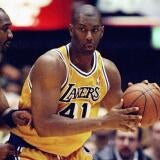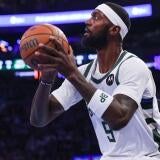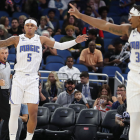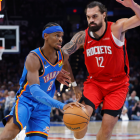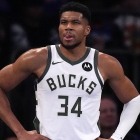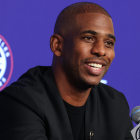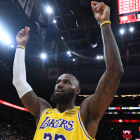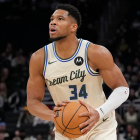From smallball to ... tall ball? The NBA is resizing again
Across the league, lineups are getting bigger (and weirder)

Orlando Magic guard Cole Anthony's first thought was, "Dang, the memes are coming true." He'd seen these memes on Twitter and TikTok: Comically colossal lineups featuring the 6-foot-10 Franz Wagner at point guard and the 7-foot-2 Bol Bol on the wing. Lineups with the collective height of two fully grown male giraffes and the collective length of a full-sized school bus. Lineups you'd never expect to see in a competitive environment outside of the 2K League.
In the first quarter of their first regular-season game, Orlando played Wagner next to Bol, Caleb Houstan, Wendell Carter Jr. and Mo Bamba. Lined up in a 3-2 zone on their first defensive possession, they raised their arms to accentuate their 37 feet of wingspan. The Detroit Pistons' Saddiq Bey passed up a corner 3 with Bamba closing out on him, then Carter rudely rejected Kevin Knox II's driving layup. Bey recovered the ball and shoveled it to Knox, whose second attempt -- a bricked 3 over Bamba's fully extended arm -- immediately validated Bey's decision.
"It's a heck of a lineup," Anthony said. "It definitely looks intimidating."
It started in summertime pickup games. Wagner wasn't even at the Magic's training center yet, as he spent most of September starring for Germany's national team at EuroBasket. No. 1 overall pick Paolo Banchero was there, though, as were Bol, Bamba and Carter.
"It's funny," Magic coach Jamahl Mosley said. "They did it on their own."
Banchero, an immensely gifted scorer and passer who stands 6-10, weighs 250 pounds and turns 20 this month, said that the bigs wanted to see how it would work. "It was fun," he said. When he was defending the perimeter, he always knew he had reinforcements near the rim to challenge shots and rebound.
"There was a good flow to it because they knew what they were doing," Mosley said. "They enjoyed it, and it's tough to score on."
Wagner and Banchero typically initiate the offense when Orlando goes super-sized, but Mosley has empowered all the bigs to be decision-makers. Against the New York Knicks last week, Bol erupted for 19 points in 20 minutes, including a coast-to-coast layup and a crossover-spin-Eurostep combo that won over the Madison Square Garden crowd. As a result of early-season injuries to all four of their sub-6-6 guards, More than 80 percent of the mountainous Magic's minutes have gone to players 6-7 and taller.
That number is an outlier, but it would not be accurate to say that Orlando is zigging while other teams zag. Leaguewide, for the first time since 2014-15, the percentage of total minutes that has gone to players 6-7 and above has risen this season, through games played on Oct. 30, according to data provided by nba.com/stats. The percentage that has gone to players 6-8 and above, 6-9 and above, 6-10 and above and 6-11 and above have also risen, all reversing recent trends. Seven-footers have been almost twice as ubiquitous (8.3 percent of total minutes, up from 4.3 percent) as they were last season, and have almost returned to levels not seen since before 2019-20, the first season in which official heights had to be certified by team doctors.
Just a year ago, the Boston Celtics' decision to start Al Horford next to Robert Williams III counted as controversial. Ime Udoka, their since-suspended coach, said in the preseason that playing two bigs is not "as much of a problem as people seem to think." The Cleveland Cavaliers' decision to start Lauri Markkanen, Evan Mobley and Jarrett Allen was downright radical. These combinations proved to be elite defensively, as did Toronto Raptors lineups featuring four or five players between 6-7 and 6-9. And after getting pushed around in the playoffs, the Minnesota Timberwolves traded for Rudy Gobert despite having another All-NBA center on the roster.
The teams that have sized up are distinct stylistically and have had wildly varying degrees of success. Broadly speaking, though, the trend is a response to the one that preceded it. The 3-point revolution stretched defenses out, opening up driving lanes and passing lanes for increasingly inventive playmakers. Bigger, longer lineups can close those lanes down by making the court "look more crowded than it actually is," Mosley said, especially if everybody plays defense with high hands.
As he said this, Mosley put his hands in the air. He does this during games, too, and, in certain arenas, his accompanying exhortation -- "Show your hands!" -- can be heard loud and clear on the broadcast. When Carter was asked how often he hears those three words shouted from the sideline, he grinned about as wide as his 7-5 wingspan.
"Shit, every time we get back on defense," he said.
Fifteen years ago, Stan Van Gundy arrived in Orlando and made the brilliant, unconventional decision to replace a 6-11 guy with a 6-10 guy. The story started at the Magic's practice facility -- an older one, without an altitude chamber, float pod or mini golf course -- where starting power forward Tony Battie tore his rotator cuff battling Dwight Howard. Van Gundy asked Rashard Lewis, who had just signed the largest contract in franchise history to be the starting 3, if he'd be willing to move to the 4 spot.
Lewis had to defend some bruisers, but on offense he and small forward Hero Turkoglu were interchangeable. With four shooters stationed around Howard, Orlando's offense exploded. It won 16 of its first 20 games, advanced in the playoffs for the first time in 12 years and made the Finals the following season.
"It's not even that long ago," Van Gundy said. "There were only a couple of teams, I think really just us and Phoenix, that were full-time playing smallball 4s. And now it's starting to shift back a little. It's interesting to me to watch the game evolve and cycle, really."
Now a TNT analyst, Van Gundy will be on the call for Tuesday's game between the Timberwolves and the Phoenix Suns, two teams that never go small. He's not sure how Karl-Anthony Towns' partnership with Gobert will work yet, but is eager to see what buttons coach Chris Finch pushes. "That's the ultimate playing big right there," he said, noting that Towns doesn't defend the perimeter as well as the bigs in Boston and Cleveland.
Early on, the big, bad Wolves have made a big jump on defense and taken a bad turn on offense. They've defended the rim better than anybody, in terms of opponent field goal percentage, but they've given up tons of 3s and struggled to create and make 3s themselves. They haven't improved their dismal defensive rebounding, but they've gone from one of the most foul-prone teams in the league to one of the least. Their 4-3 record is not encouraging, but, in an experiment of these proportions, the various elements might need some time to coalesce.
In Van Gundy's view, the success of the Celtics, who had the best defense in the NBA last season and the No. 2 offense from January onward, has a lot to do with the league trending taller. They had size at every position, no weak defenders in their top seven, the Defensive Player of the Year at the point of attack and a game-changing center roaming off poor shooters. Most teams can't assemble that much defensive talent, but all of them can look for sturdy, switchable guards and mobile bigs. Versatility is so valuable that vertically challenged guards are vanishing.
"They've gotta be great offensive weapons," Van Gundy said. "They can't be just a mediocre, even a middle-of-the-road starting point guard offensively because of the problems they put you in on defense."
Before calling Boston's season opener, Van Gundy chatted with interim coach Joe Mazzulla about one of the benefits of playing multiple bigs: If one is lured out of the paint on a switch, the other can still protect the rim.
"With everything else even, bigger is certainly better than smaller," Van Gundy said.
As the league gets larger, Van Gundy expects the post-up to come back from the dead. "It'll be gradual," he said, but the rationale is simple: Offense is fundamentally about forcing the defense to put two defenders on the ball, so you can move it and find an open shot."We used to be able to create that in pick-and-rolls, but now, with all the switching, people stay matched up man-to-man." For a team like the New Orleans Pelicans, throwing the ball to Zion Williamson, Jonas Valanciunas or Brandon Ingram on the block is a viable alternative.
"Now you either better have somebody who can guard those guys one-on-one," Van Gundy said, "or you gotta come down with a second defender and you have all of that."
Van Gundy is not the first person to forecast a post-up renaissance. After eight straight seasons in which the number of possessions that ended with a post-up declined leaguewide, there has been a slight increase this season, per Synergy Sports. This year's Pelicans are finishing more possessions with a post-up than any team since 2019, aside from two iterations of Joel Embiid's Philadelphia 76ers. The Dallas Mavericks are also one of the five most post-heavy teams of the past four seasons; coach Jason Kidd, who predicted the post-up would come back in a 2015 Grantland story by Zach Lowe, has put Luka Doncic in the post more often than anybody but Embiid.
Posting up is one way to use size and counter switches, as long as you commit to getting the ball inside against mismatches and can make the entry pass before the defense "scrams" the smaller defender out of trouble. Another way is to pound the offensive glass. After reaching a nadir in 2020-21, second-chance possessions have increased leaguewide in each of the last two seasons, according to pbpstats.com.
Van Gundy credits Memphis Grizzlies coach Taylor Jenkins for bringing offensive rebounding back. Only two teams have recorded a higher offensive rebounding percentage than the 2021-22 Grizzlies since "Grand Theft Auto V" was released for the PlayStation 3 and Xbox 360, and on a per-possession basis Memphis scored more second-chance points last season than any team since "The Legend of Zelda: Ocarina of Time" was released for the Nintendo 64.
Grizzlies center Steven Adams is difficult to keep off the glass, and he played the majority of his minutes with the 6-10 Jaren Jackson Jr. next to him last year. "It's not just size on the offensive boards, though," Van Gundy said. "What really creates offensive rebounds are the teams that can attack the basket off the dribble." Drive and draw help, and the defense has to take a body off of one of your bigs.
This is particularly effective when a lumbering big has switched onto a perimeter player, and even more so when that perimeter player is an unguardable creative genius. Sometimes, when Ja Morant sees help coming, he just throws it off the glass so a fellow Grizzly can go get it. In their second game of the season, Doncic gave Memphis a taste of its own medicine.
Twelve teams have scored more than 15 second-chance points per 100 possessions in 2022-23, the most in a decade. In 2020-21, none did. Coaches are not just rethinking the assumed trade-off between crashing the boards and transition defense -- last year's Raptors were second in offensive rebounding percentage and second in limiting opponents' transition opportunities, per Cleaning The Glass -- but rethinking it entirely: If you establish a reputation on the boards, then opponents might start sending extra bodies there on defense, crippling their transition game in the process.
"It puts pressure on the defense, not letting them necessarily get run-outs," Mosley said.
Before Toronto's shootaround at the National Basketball Players Association office in Midtown Manhattan, the 6-8 Thaddeus Young gestured toward a humungous rookie working on one-dribble hook shots.
"That's a lost art in this league," Young said. "Simple stuff like that is just going to make him such a good basketball player. He's just going to continue to grow his game. He's so young."
Christian Koloko is the Raptors' only 7-footer, and he's their first player taller than 6-10 since a disappointing dalliance with Aron Baynes in Tampa Bay. His upside as a rim protector is obvious, given his 7-5-plus wingspan, but, unlike others with similar dimensions, he's not always hanging around the paint and dropping in pick-and-roll coverage.
"He's moving," Young said.
Last week, Koloko deflected a pass intended for Embiid, his fellow Cameroonian, at the elbow, then took off for a steal and a fast break, taking giant strides and only one dribble before throwing down a dunk on the opposite end. In a rematch two days later, he trapped James Harden at the logo, then sprinted to the baseline in time to beat a bunch of stationary Sixers to a loose ball. Height and inexperience are all that separate Koloko from the rest of Toronto's fast and athletic rotation.
"Christian's going to be good," Young said. "He's going to be really good."
The same year that Van Gundy introduced the Magic to 4-out spacing, Young started his NBA career as a 3/4 in Philadelphia. He transitioned to power forward full time in Year 4 and reinvented himself as a playmaking 5 in Year 14. Now in Year 16, positions no longer mean much to him.
"I don't have one," Young said. "I play all over the court."
Young has seen the league change every three or four years, he said. "That's the part I love about it: It evolves and it gives me a chance to evolve with it." When one team succeeds in a new way, others give it a try. Perhaps if the 2019-20 Houston Rockets, who traded Clint Capela midseason, started P.J. Tucker at "center" and turned Robert Covington into an elite shot-blocker, had managed to beat the eventual-champion Los Angeles Lakers in the bubble, the NBA would be tiny today. Perhaps if this year's Timberwolves cohere into something special, it will be enormous tomorrow.
When the 6-5 Tucker and the 6-6 Draymond Green started at 5 in the 2018 Western Conference finals, it felt like the giants had been slayed. But while those leaders of the positional revolution inspired and open doors for players who might have been dismissed otherwise, it's not as if there are tons of Draymonds out there.
"You want to play smallball at the 5?" Van Gundy said. "Well, who's your smallball 5 who then can guard at the other end, rebound the ball and then facilitate things offensively? I mean, there's not a lot of those guys. There's probably as few of those guys, honestly, as there are Joel Embiids who can go down there and dominate a game now."
The model, at present, is to use smallball as a counterpunch. Since the Golden State Warriors unveiled the "Death Lineup" in 2015, virtually every championship team has followed their footsteps, either downsizing their starting lineup near the finish line or shifting shapes along the way. "Ideally as a team you want to have a lot of versatility and flexibility to be able to play lineups situationally," Van Gundy said. Going small or going big to match up with the opponent won't always work, but every coach would like to have options.
If the question is whether to go big or small, though, the Raptors' answer is, "Go away." They have an All-Star who stands 6 feet tall and loves it when bigger players target him on defense. They don't have anyone you'd call a center in the starting lineup, but they have two point-forward types who draw double-teams in the post and initiate the offense from the perimeter; one made All-NBA last year, the other won Rookie of the Year. They are fanatically devoted to applying defensive pressure, and they cover for each other with long arms and quick feet.
At one point in Koloko's debut, he shared the court with Precious Achiuwa, Pascal Siakam, Dalano Banton and Young. When Fred VanVleet had to miss Monday's game, Koloko started in his place, which would have seemed weird if coach Nick Nurse hadn't gone gargantuan before. Asked if Orlando's meme-worthy jumbo lineups indicate that Toronto is influencing others, Young said, "Could be."
More than a decade ago, Young co-founded Team Thad, a Memphis-based AAU program that now plays in Nike's EYBL circuit and counts his teammate O.G. Anunoby as one of its alumni. "These young kids are becoming so much more talented than I was as a kid, anybody else was as a kid, just through training and doing certain things that they're seeing on TV," he said. If every tall kid models his game after the position-fluid, do-everything stars that dominate the NBA, then there will be more position-fluid, do-everything stars in the NBA.
"I think the assumption that people make always is that if a trend starts, it's just going to continue to go in that direction forever," Van Gundy said. "'Twenty years down the road, we're going to be playing small,' no. What we're going to really see is more skilled bigger people."
Three days ago, the NBA's official app streamed a game played in a small arena in Eastern France, and it will continue to beam Victor Wembanyama's 8-foot wingspan onto screens of all sizes. It would be a stretch bigger than that to suggest that you can see the future just as clearly in Orlando, but if you can look past the 1-6 record and the inefficient offense, you might be able to get a bit of a glimpse.
"Let's forget about Wembanyama, he's a freak," Van Gundy said. "But as you get guys like Banchero and guys like that who can play out on the perimeter, you don't have to play small to get skill."
No matter how many 7-footers are on the court, Orlando's offense remains the same: Five players around the 3-point line, all with the green light to shoot 3s. "The league is changing," Carter said. Then he corrected himself: "The league has changed." To 10-year veteran Terrence Ross, the only Magic player with more than four years of experience who has suited up this season, there's no doubt this is where this is all going.
"Yeah, bro," Ross said. "It's going to be just really a skilled bigs' league."


